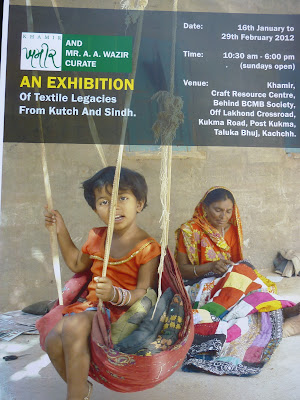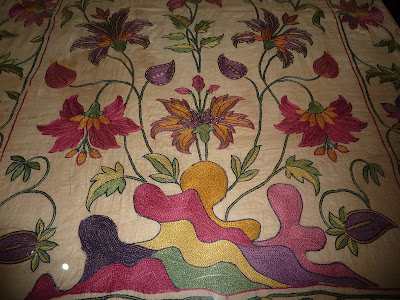Have you ever seen the Woody Allen film
Midnight in Paris? I saw it with my family when it came out in the theater last year, and wasn’t particularly impressed – I found it very visually compelling and liked the idea of someone going back in time to the “golden era” of Paris (who wouldn’t want to meet F. Scott Fitzgerald, Gertrude Stein, and Pablo Picasso?) - but I felt that Woody Allen’s humor was too forced, which ultimately clouded my enjoyment of the film itself. Then last week my friend lent me the movie and I decided to give it another try.
Sometimes you have to see a film (or read a book, etc) at the right time and in the right place for it to have meaning. And somehow, this time, the movie spoke to me in a new way.
Two months ago, I was feeling extremely rooted and present in Bhuj, but for the past few weeks, I have slowly begun to hover above my experience. I am still very much here, yet I occasionally have the distinct feeling that something is askew, like I have stepped backwards out of the scene and become a voyeur, viewing my surroundings through a screen. Then I jolt myself back into the moment.
I think my subconscious is starting to prepare to recontextualize my current experience as memory. Without realizing it I am already selecting experiences to file away for later review, feeling the bubble of nostalgia rise inside me even as I am experiencing something new.
I have begun to have dreams that I am back in the US, confronted with the reality of being home. I will be standing in the cereal aisle in the grocery store, overwhelmed by the brightly colored boxes towering before me, and long for the simplicity of the vegetable stand where I pay 55 rupees for an entire meal’s worth of vegetables and fruits. Or I will step through my front door in Minnesota for the first time in months, ecstatic to see my family and home again, then go up to my bedroom to deposit the relics of India in the emptiness of an unlived-in room. And I will be overwhelmed with an ache in my core, like something inside me has just died. Then I wake up, confused.
Which is real? My experience here and now in Bhuj, or my past and future life in the US?
As I watched
Midnight in Paris, what stood out to me this time was not the flashiness or the time travel, it was the idea of escapism and nostalgia. In the movie, the main character, Paul, goes back in time to the “golden era” of Paris, escaping into another world that he considers superior to his own. He slowly separates himself from his present, enveloping himself in that “other” world, even falling in love with a woman of the 1920’s, Ines. At the end (spoiler!), the two go back in time to Ines’ “Golden age” - fin de siècle Paris, the time of Toulouse Latrec and Degas- escaping even further into the recesses of nostalgia. Just as Paul is enticed by the prospect of living in the ‘20s, Ines is drawn to her own version of the nostalgic past. This is when Paul realizes that, basically, no one is ever happy with what they have.
“Nostalgia is denial - denial of the painful present . . . the name for this denial is golden age thinking - the erroneous notion that a different time period is better than the one one is living in – it’s a flaw in the romantic imagination of those people who find it difficult to cope with the present.”
As I watched, I was struck by the notion that I was Paul – that I am elevating Bhuj and India in my mind as a way of avoiding the painful realities of life in America. Let’s just dismiss the problematic component of me equating Bhuj with the past and America with the present - I recognize and disagree with the colonial implications of saying India is “behind the times”. Instead, let’s focus on the idea of inhabiting multiple worlds, on the idea of nostalgia as a form of escapism.
You might recall
an earlier post where I was feeling nostalgic for America. At that moment (which, admittedly, was only a moment) the envelop of “otherness” in Bhuj felt stifling, both because I was overwhelmed by the cultural differences and because I was sick of being objectified as “the American”. I longed to be home, where I could escape into the familiar. At that point, Bhuj was “the present” that felt difficult and America “the past” that felt safe. But somehow in the last few months that has changed.
Now, as I reorganize my brain and Bhuj becomes "the past", a tint of romanticism is beginning to color my perception of life here. Because I am beyond the "basics", having settled into a pace of life in Bhuj that feels comfortable, I can focus on the good stuff. I can revel in the fact that I am always challenged to think in a new way, constantly confronted by surprising cultural similarities and differences. But if I stayed, would that magic be gone? And how much of it is just me "finding it difficult to cope with the present?" aka America?
At home I have to deal with planning for my future, with money, with social and political realities that are very much a part of who I am, not a study in social and cultural difference. I am not a visitor in the US- I am a resident. And that requires a very different kind of responsibility.
In addition, while I have been away many things have changed, and I don’t know quite what I will find or how I will deal with them when I return. I have changed and grown too, and fear that I will lose the things I have gained as soon as my context reminds me who I was before.
But the difference between my situation and Paul’s in the movie is that he is nostalgic for a past that no longer exists. My Bhuj – which is very specific to this moment in time - will no longer exist when I leave, but Bhuj itself – the real Bhuj – will. It will continue to grow and change, just as I will.
At the end of the movie, Paul chooses to return to the present but make changes in his life that reflect the changes in himself. I hope to do the same. I hope to continue seeking environments where I am challenged to think differently. I hope to be an active student of the small moments. And I hope to come back to Bhuj, and to see how both of us have continued to grow.
Okay Woody, you've won me over on this one.



























































